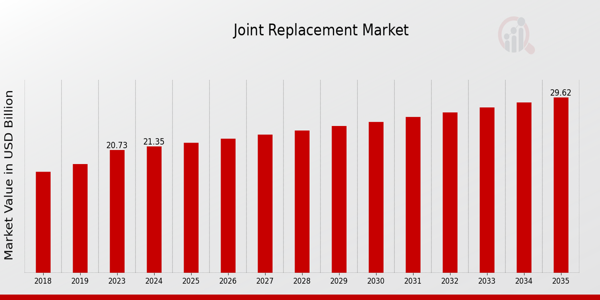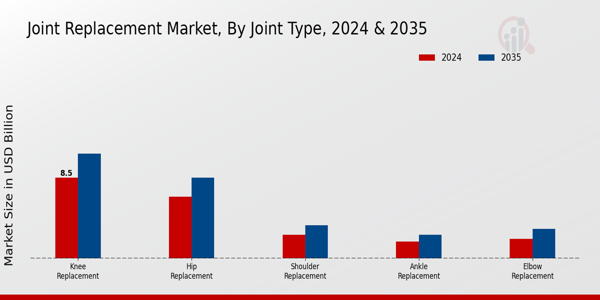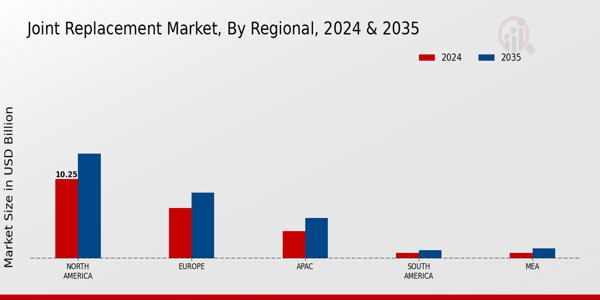Joint Replacement Market Overview
As per MRFR analysis, the Joint Replacement Market Size was estimated at 20.73 (USD Billion) in 2023. The Joint Replacement Market Industry is expected to grow from 21.35 (USD Billion) in 2024 to 29.6 (USD Billion) by 2035. The Joint Replacement Market CAGR (growth rate) is expected to be around 3.02% during the forecast period (2025 - 2035).
Key Joint Replacement Market Trends Highlighted
The Global Joint Replacement Market is witnessing significant growth driven by an aging population and increasing prevalence of orthopedic disorders. Advances in surgical techniques and implant technology are enhancing the quality of procedures and outcomes, attracting more patients. Furthermore, the growing awareness about orthopedic health and rising disposable incomes enable more people to seek treatment, leading to a greater demand for joint replacement solutions.
The shift toward minimally invasive surgeries is also a critical driver, as it often results in shorter recovery times and less postoperative pain, appealing to both patients and healthcare providers.The market's personalized medicine and technological innovation are creating opportunities. Businesses that invest in smart healthcare materials, for example, biocompatible materials and monitoring implants, can target a larger consumer base seeking better services and outcomes.
Furthermore, the developing world presents new opportunities for businesses as their healthcare infrastructure grows and the demand for orthopedic services continues to rise. Joint replacement surgery may also become more accessible through partnerships between manufacturers and healthcare systems. It seems there is a trend toward outpatient surgery and an emphasis on rehabilitation after surgery and effective recovery.
The integration of digital solutions, such as telemedicine and remote monitoring, is reshaping patient care. With a growing emphasis on value-based healthcare, stakeholders are prioritizing patient-centric approaches, ensuring better satisfaction and health outcomes. Such trends point toward a more holistic view of treatment that not only addresses physical surgery but also supports recovery and long-term health management. Overall, the Global Joint Replacement Market is positioned for substantial progress as it adapts to evolving patient needs and innovative technologies.

Source: Primary Research, Secondary Research, MRFR Database and Analyst Review
Joint Replacement Market Drivers
Increasing Prevalence of Joint Disorders
The Global Joint Replacement Market Industry is experiencing significant growth due to the increasing prevalence of joint disorders such as osteoarthritis and rheumatoid arthritis. As the global population ages, these conditions become more common, leading to a higher demand for joint replacement surgeries. With an aging demographic more susceptible to joint-related issues, healthcare systems are witnessing a rise in diagnostic and treatment requirements.This trend is further exacerbated by factors such as obesity and sedentary lifestyles, which contribute to joint problems. Consequently, more individuals are seeking surgical interventions to alleviate pain and restore normal function, driving the need for joint replacement solutions.
The ongoing advancements in surgical techniques and implant materials also enhance the feasibility and safety of these procedures, making joint replacements a preferred choice among patients and healthcare providers alike.With the expected growth in market valuation, the landscape for joint replacement is likely to evolve, presenting new opportunities for manufacturers who can meet the demands for innovative and effective solutions. As a result, the urgency surrounding these disorders plays a crucial role in propelling the Global Joint Replacement Market forward, creating pathways for improved patient outcomes and enhanced quality of life.
Technological Advancements in Joint Replacement
Innovation in surgical technologies and prosthetic designs is a key driver for the Global Joint Replacement Market Industry. Recent advancements in minimally invasive surgical techniques allow for quicker recovery times and reduced hospital stays, appealing to patients seeking less invasive options. Moreover, the introduction of robotics and computer-assisted surgery has significantly increased the precision and efficacy of joint replacement procedures.These technologies enable orthopedic surgeons to perform more successful surgeries, minimizing complications and enhancing patient satisfaction with outcomes. As the market progresses, the integration of smart technologies with joint implants is also on the rise, providing tools for better post-operative monitoring and care.
Growing Health Awareness and Focus on Quality of Life
There is a notable increase in health consciousness among the global populace, particularly as it pertains to maintaining a quality lifestyle. Individuals recognize the importance of mobility and the adverse effects of joint pain on daily activities. This growing health awareness drives demand for joint replacement procedures as patients actively seek ways to improve their quality of life. The emphasis on health and wellness encourages individuals to explore treatment options for debilitating joint conditions, thereby expanding the market for joint replacements.Furthermore, supportive healthcare policies and increased access to orthopedic care enhance patient engagement in managing health, further driving the growth of the Global Joint Replacement Market Industry.
Joint Replacement Market Segment Insights
Joint Replacement Market Joint Type Insights
The Global Joint Replacement Market revolves around various joint types, which significantly contribute to overall growth and development. In 2024, the market reached a notable valuation of 21.35 USD Billion, indicating robust activity within the sector, with a projected increase to 29.6 USD Billion by 2035. Within this market segmentation, Knee Replacement stands out as a leading category, with an estimated value of 8.5 USD Billion in 2024 and expected growth to 11.0 USD Billion by 2035, highlighting its majority holding within the overall market landscape.This prominence can be attributed to the high prevalence of knee-related disorders and an aging population, driving demand for these procedures.
Following closely is Hip Replacement, valued at 6.5 USD Billion in 2024, with projections raising it to 8.5 USD Billion by 2035, emphasizing its significance due to the increasing incidence of hip ailments among the elderly, which necessitates surgical interventions. Shoulder Replacement, holding a value of 2.5 USD Billion in 2024 and anticipated to reach 3.5 USD Billion by 2035, also plays a crucial role in the market as conditions like rotator cuff injuries and arthritis gain traction.Ankle Replacement, with a valuation of 1.8 USD Billion in 2024 and a rise to 2.5 USD Billion by 2035, although smaller than other categories, reflects the growing awareness and acceptance of surgical solutions for chronic ankle pain. Lastly, Elbow Replacement, valued at 2.05 USD Billion in 2024 and expected to increase to 3.1 USD Billion by 2035, while relatively less dominant, demonstrates a steady growth trajectory, appealing to individuals suffering from severe elbow damage.
The market trends showcase an emphasis on improved surgical techniques and implants.Growth drivers include rising healthcare expenditures, technological advancements in joint replacements, and an increasing emphasis on patient satisfaction. While opportunities abound in the form of emerging markets and advancements in materials and methods, challenges such as high costs and surgical risks need to be addressed. Overall, the Global Joint Replacement Market segmentation, especially through the Joint Type lens, underscores the importance of various segments while mapping the overall landscape geared towards enhancing surgical solutions and patient care.

Source: Primary Research, Secondary Research, MRFR Database and Analyst Review
Joint Replacement Market Material Insights
The Global Joint Replacement Market, valued at 21.35 USD billion in 2024, presents a diverse material segmentation that plays a crucial role in the performance and longevity of joint replacement implants. Key materials such as Metal, Ceramic, Polymer, Composite, and Alloys are employed based on specific applications and patient needs. Metals, particularly titanium and cobalt-chrome, are predominant due to their strength and durability, making them a preferred choice in load-bearing implants. Ceramics are notable for their biocompatibility and wear resistance, proving significant in hip and knee applications.Polymers like polyethylene are widely utilized for their flexibility and cushioning properties, often enhancing patient comfort.
Composites and alloys combine various properties to produce bespoke solutions targeted at improving outcomes in complex cases. The Global Joint Replacement Market statistics reveal that advancements in material technology are ongoing, driven by developments in biocompatibility and innovative manufacturing processes. The market growth is further supported by rising aging populations and increasing orthopedic surgeries.However, challenges such as material rejection and wear over time persist, presenting opportunities for research into new material compositions that could enhance performance and patient satisfaction. As the market evolves, material selection remains integral to advancing joint replacement solutions.
Joint Replacement Market Surgical Approach Insights
The Surgical Approach segment of the Global Joint Replacement Market has seen distinctive evolution, driven by advancements in technology and shifting patient preferences. By 2024, the overall market is poised to be valued at 21.35 billion USD, showcasing a steady growth trajectory. Among various surgical methodologies, Minimally Invasive Surgery has gained traction owing to its reduced recovery time and lower postoperative complications, making it a preferred approach for many patients.
Open Surgery, while traditional, remains crucial for complex cases where thorough exploration is necessary, often dominating surgeries involving extensive joint damage.Robotic-Assisted Surgery is emerging as a significant enabler in precision-based approaches, enhancing capabilities for surgeons and improving outcomes for patients. These diverse surgical methods exhibit the market's focus on patient-centered care, with a growing preference for less invasive alternatives. As the Global Joint Replacement Market continues to expand, these insights indicate the importance of tailoring surgical approaches to meet diverse patient needs, ultimately aligning with the broader trends of improved care delivery and technology adaptation in the industry.
Joint Replacement Market End User Insights
The Global Joint Replacement Market demonstrates significant growth potential, propelled by various end users such as hospitals, orthopedic clinics, and ambulatory surgical centers. By 2024, the market was expected to hold a valuation of 21.35 billion USD, showcasing a strong demand for joint replacement procedures across these settings. Hospitals have traditionally dominated this space due to their comprehensive capabilities and equipment, enabling the handling of complex surgeries. Meanwhile, orthopedic clinics have gained traction as they offer specialized services with a focus on joint replacement, delivering high-quality patient care and targeted expertise.Ambulatory surgical centers also play a crucial role, providing cost-effective and efficient surgical options for patients, appealing particularly to those seeking outpatient services.
The growing elderly population and the rising prevalence of orthopedic disorders act as key growth drivers while challenges such as surgical risks and recovery issues persist. Nevertheless, opportunities remain vast for innovation in joint replacement techniques and improved patient outcomes, ensuring the market growth continues to align with the evolving healthcare landscape.Employing effective strategies and understanding the Global Joint Replacement Market data will be essential for businesses to thrive in this competitive industry.
Joint Replacement Market Regional Insights
The Global Joint Replacement Market exhibits significant regional diversification, with North America leading at a valuation of 10.25 USD Billion in 2024, projected to reach 13.5 USD Billion by 2035, demonstrating its majority holding in the market. This region's prominence can be attributed to advanced healthcare infrastructure and higher incidences of joint-related disorders. Europe follows with a valuation of 6.5 USD Billion in 2024, anticipated to grow to 8.5 USD Billion by 2035, showing its significant involvement due to an aging population and increasing health awareness.
The APAC region, valued at 3.5 USD Billion in 2024 and expected to reach 5.2 USD Billion by 2035, reflects a growing demand driven by rising healthcare expenditures and improving medical services. In contrast, South America and MEA both hold smaller market shares, with valuations of 0.75 USD Billion in 2024 for each, rising to 1.1 USD Billion and 1.3 USD Billion, respectively, by 2035. These regions face challenges related to healthcare accessibility and economic variability, yet they present considerable opportunities for growth given their developing healthcare landscapes.Overall, the Global Joint Replacement Market segmentation highlights North America and Europe as dominant players, while APAC displays potential for robust growth due to its expanding healthcare sector and increasing population.

Source: Primary Research, Secondary Research, MRFR Database and Analyst Review
Joint Replacement Market Key Players and Competitive Insights
The Global Joint Replacement Market has witnessed significant growth driven by an aging population, increasing prevalence of degenerative joint diseases, and advancements in surgical technology. The competitive landscape of this market is characterized by a diverse range of players, including global med-tech companies and specialized orthopedic firms. These companies are actively engaged in innovation, which includes the development of novel implant materials and minimally invasive surgical techniques to enhance patient outcomes. Additionally, market players are focusing on strategic collaborations and partnerships to expand their product portfolio and tap into emerging markets, thus intensifying competition.
The environment is further shaped by regulatory challenges, pricing pressures, and the need for effective post-operative care solutions, compelling companies to optimize their operations and strategically position their offerings.ConMed is a notable contender in the Global Joint Replacement Market, leveraging its robust product portfolio and proven expertise in orthopedic surgery. The company has established a strong presence by delivering a wide range of innovative joint replacement products designed to improve surgical success rates and enhance patient recovery. ConMed's commitment to research and development has enabled it to stay ahead of the curve, introducing advanced technologies that cater to the unique needs of orthopedic surgeons and their patients.
Furthermore, ConMed's strategic collaborations with healthcare institutions enhance its market credibility, allowing it to respond effectively to the evolving demands of the joint replacement landscape. The company's ability to provide comprehensive training programs and ongoing support for surgical teams significantly strengthens its position in the market.NuVasive also plays a vital role in the Global Joint Replacement Market, particularly known for its commitment to advanced technology and minimally invasive surgical solutions. The company focuses on developing innovative spinal and orthopedic products that improve surgical outcomes and reduce recovery times for patients. NuVasive's market presence is bolstered by its strong emphasis on clinical evidence, aiding healthcare providers in adopting its solutions confidently.
The company is dedicated to enhancing surgical efficiency and patient care through its state-of-the-art technology, which allows for precise implantation techniques and reduced trauma during surgery. NuVasive’s collaborative approach with orthopedic surgeons fosters continuous improvement and innovation in joint replacement procedures, thereby reinforcing its competitive edge within the market. The company’s strategic initiatives are aimed at expanding its global reach and ensuring it remains a key player in the evolving landscape of joint replacement.
Key Companies in the Joint Replacement Market Include:
- ConMed
- NuVasive
- Amgen
- Johnson and Johnson
- Wright Medical Group
- Smith and Nephew
- DePuy Synthes
- Boston Scientific
- B. Braun
- MicroPort
- Invibio
- Zimmer Biomet
- Stryker
- Medtronic
- Exactech
Joint Replacement Market Industry Developments
The Global Joint Replacement Market has recently experienced various advancements and changes. Companies such as Johnson & Johnson and Stryker are focusing on innovative technologies to enhance the effectiveness of joint replacement procedures, which is reflective of a broader trend toward personalized medicine in orthopedics. Notably, Zimmer Biomet has reported growth in its product lines, which has positively influenced the market valuation, making joint replacements more accessible. Merger and acquisition activity has also been significant, with Wright Medical Group making strides to enhance its market share through strategic alignments.
Additionally, NuVasive and Medtronic have engaged in discussions regarding collaborative efforts aimed at expanding their joint solutions portfolio. It is worth mentioning that Smith & Nephew has unveiled new product offerings aimed at improving recovery times for patients, thus impacting market dynamics. The rise in demand for minimally invasive surgeries has further driven companies like ConMed and Boston Scientific to innovate their joint replacement technologies. These developments indicate a transformative phase in the Global Joint Replacement Market, with robust competition among key players leading to advancements in surgical solutions and improved patient outcomes.
Joint Replacement Market Segmentation Insights
Joint Replacement Market Joint Type Outlook
- Knee Replacement
- Hip Replacement
- Shoulder Replacement
- Ankle Replacement
- Elbow Replacement
Joint Replacement Market Material Outlook
- Metal
- Ceramic
- Polymer
- Composite
- Alloys
Joint Replacement Market Surgical Approach Outlook
- Minimally Invasive Surgery
- Open Surgery
- Robotic-Assisted Surgery
Joint Replacement Market End User Outlook
- Hospitals
- Orthopedic Clinics
- Ambulatory Surgical Centers
Joint Replacement Market Regional Outlook
- North America
- Europe
- South America
- Asia Pacific
- Middle East and Africa
| Attribute/Metric Source: |
Details |
| MARKET SIZE 2023 |
20.73(USD Billion) |
| MARKET SIZE 2024 |
21.35(USD Billion) |
| MARKET SIZE 2035 |
29.6(USD Billion) |
| COMPOUND ANNUAL GROWTH RATE (CAGR) |
3.02% (2025 - 2035) |
| REPORT COVERAGE |
Revenue Forecast, Competitive Landscape, Growth Factors, and Trends |
| BASE YEAR |
2024 |
| MARKET FORECAST PERIOD |
2025 - 2035 |
| HISTORICAL DATA |
2019 - 2024 |
| MARKET FORECAST UNITS |
USD Billion |
| KEY COMPANIES PROFILED |
ConMed, NuVasive, Amgen, Johnson and Johnson, Wright Medical Group, Smith and Nephew, DePuy Synthes, Boston Scientific, B. Braun, MicroPort, Invibio, Zimmer Biomet, Stryker, Medtronic, Exactech |
| SEGMENTS COVERED |
Joint Type, Material, Surgical Approach, End User, Regional |
| KEY MARKET OPPORTUNITIES |
Rising aging population demand, Technological advancements in implants, Increasing prevalence of orthopedic diseases, Growth in minimally invasive surgeries, Expanding healthcare infrastructure globally |
| KEY MARKET DYNAMICS |
Aging population growth, Rising prevalence of arthritis, Advancements in surgical techniques, Increasing healthcare expenditure, Growing demand for minimally invasive procedures |
| COUNTRIES COVERED |
North America, Europe, APAC, South America, MEA |
Frequently Asked Questions (FAQ) :
The Global Joint Replacement Market is expected to be valued at 21.35 USD Billion in 2024.
The market is projected to reach a value of 29.6 USD Billion by 2035.
The anticipated CAGR for the Global Joint Replacement Market is 3.02% during the period from 2025 to 2035.
North America is expected to dominate the market with a valuation of 10.25 USD Billion in 2024.
The Hip Replacement segment is projected to be valued at 8.5 USD Billion by 2035.
Major players include ConMed, NuVasive, Amgen, Johnson and Johnson, and Zimmer Biomet among others.
The Asia-Pacific region is expected to grow to 5.2 USD Billion by 2035.
The Knee Replacement segment is valued at 8.5 USD Billion in 2024.
The Elbow Replacement segment is projected to be valued at 3.1 USD Billion by 2035.
The market is witnessing growth driven by advancements in surgical technologies and increasing aging population.

















